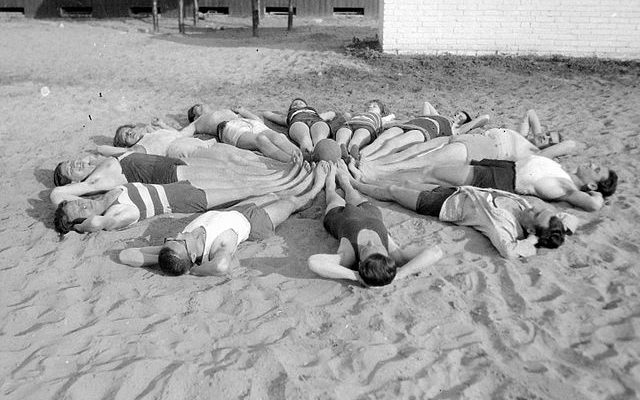I was in a freshman high school health class when she asked the question. It was my first class of the year and I was in the middle of my presentation about how to navigate messages about sex found in different media.
Kids love this part. If they weren’t eager to participate before, being allowed to tell me why Fifty Shades of Grey is a poor depiction of a romantic relationship gets them talking.
She was one of those young women you see and already know has a hard time in school; dark, dingy clothes, a knit hat over unkempt hair, and the kind of glasses that are really just glasses and not a fashion statement.
I had just asked the class to list positive and negative sex messages they’ve seen in different forms of social media when she raised her hand and said, “Well, on Tumblr you see role-playing things, like daddy on little girl stuff.”
Now, I have spent over two years leading sexual integrity presentations in public high schools and youth groups. There’s not a lot that students say that shocks me. If I’m surprised by something they know about, I try to hide this so as not to shame them.
So, I simply nodded and went to write “Tumblr” on the board when she suddenly added, “And that would be a positive depiction of sex.”
I could feel the excited energy of the room disperse a little as I turned back towards her, now really trying to hide my shock.
“Okay,” I said slowly, “can you clarify what you mean by that?”
“Well, you know, it’s only role-playing. And people seem to have fun while they’re doing it,” she answered without missing a beat.
The room became quiet except for a few nervous whispers. I tried to come up with a response. I could feel the teacher watching me as I explained why such a role-playing scenario actually was a negative and deeply unhealthy depiction of sex.
I wish I could say these types of answers from students were not common.
This interaction took place in the fall of 2015, the same year the Internet couldn’t decide whether a dress was blue or black. The same year Bruce Jenner became Caitlin. The same year the world spent 4.3 billion hours[i] on PornHub, one of the most popular internet pornography sites (that’s a total of 87,849,731,608 porn videos viewed). Tumblr, by the way, is not a porn site. It’s a social media platform used predominantly by teens where pornographic images can often be found, just like other “non-pornographic” sites or apps used by teens like Facebook, Instagram, and Snapchat.
Based on a 2008 study of 560 college students, it is estimated that 93% of boys and 62% of girls are exposed to online pornography before they turn 18.[ii] The implications of this statistic are enormous, and not just because it means that a child or teen being exposed to pornography is no longer a matter of “if” but a matter of “when.”
For people who work with youth, it cannot be a choice whether or not to include pornography in the conversations about sex. It’s a conversation we have to have with teens. Pornography is doing deep damage to the way our culture views and practices sex and wreaking havoc on the health of individuals and romantic relationships.
When Utah declared porn a public health crisis in April, many critics of the resolution claimed Governor Gary Herbert ‘s rally against porn was based upon morality issues rather than scientific facts. And while morality might not win out in a public sphere, it is an aspect of pornography youth workers cannot and should not ignore.
When I talk about pornography in a public high school health classroom, I am legally bound to not discuss any topic from a faith point of view. When I present in a youth group setting, I have the amazing opportunity to speak from a scientific and faith perspective. This is where the magic happens.
When working with teens that are just discovering numerous aspects about their world and deciding what ideas to trust, the topic of sex can be tricky. On one hand, it would make the job of a youth worker ten times easier if simply speaking to God’s beautiful biblical truth about waiting for marriage worked every time. When I was a teen, I took to heart God’s design for sex, but what really helped me wait was knowing I could get pregnant and understanding the chemical reaction during sex that forms an emotional connection to your partner. As a teen, I needed both the moral and the scientific. The same is true for conversations about pornography.
So how do we do this?
Talk About The Holiness of Curiosity
We have to communicate to teens (both boys and girls) that their desire and curiosity for sex and romantic relationships is ultimately healthy (and holy). In the creation story of Genesis 2, we learn that God creates man and woman very much on purpose to flourish in what is in fact a sexual, marriage relationship. Their bodies and genders were not a mistake. In fact, one of my favorite things to tell teens is that we were sexual before we were ever sinful. Sex and our desire for it is not a result of sin entering the world. What is a result of sin are the unhealthy ways in which we indulge in this desire, whether mentally or physically, with pornography being a huge, damaging example.
If teens argue that watching porn is better than actually having sex, they need to understand that if they are waiting to have sex, pornography will hinder their journey.
In an anonymous survey published by the Journal of Adolescent Health in 2009, it was reported that adolescents exposed to pornographic websites are more likely to have multiple lifetime sexual partners.[iii] And if the average age of first exposure to pornography is 11 years old,[iv] think of what years of reinforcement through pornography viewing is doing to teens and young adults trying to follow God’s design for sex.
It is crucial to communicate to teens that watching porn is not a Band-Aid for their sexual desires, one they can indulge in for a few minutes and be done with until the next time. Porn has lasting consequences that will not only impact them but their future relationships as well, with consequences[v] including:
- A belief that promiscuity is the natural state.
- A belief that marriage is sexually confining.
- The abandonment of hope of sexual monogamy.
- A belief that sexual inactivity and abstinence are unhealthy.
- Diminished trust between intimate couples.
Doesn’t sound like such a great alternative, does it?
Talk About the Celebration of the Union
In Song of Songs, the sexual relationship between a man and woman is celebrated and cherished. The way in which these two describe each other, even going so far as to revel in their partner’s physical appearance, is an eye-opening interpretation of the beauty of sex. Through scripture, we are meant to understand the magnitude of sex and its unmatched ability to unite two people in marriage: “That is why a man leaves his father and mother and is united to his wife, and they became one flesh.” (Genesis 2:24, NIV).
The job of the youth worker is to communicate to teens that sex is not the issue; porn is the issue.
In porn, 88% of scenes contain physical aggression (primarily directed towards women) and 49% of scenes contain verbal aggression.[vi] Pornography teaches young people a warped version of sex, that it can be experienced whenever, with whomever, in unlimited situations of partners, contexts, and with zero emotional attachment or repercussions. Pornography teaches its viewers that sex (and people) is a commodity to be used merely for physical pleasure and power.
By indulging in pornography, teens not only diminish their ability to believe God’s truth about sex, but train their minds to focus on unhealthy and even dark ideas about sex and sexuality, as porn has been proven to rewire the viewer’s brain.[vii] Philippians 4 calls people to “Fix your thoughts on what is true, and honorable, and right, and pure, and lovely, and admirable. Think about things that are excellent and worthy of praise.” (NLT)
Address the Alternative Universe that Porn Creates
Watching porn and dwelling on graphic images and ideas of bodies, violence, relationships, and sexual acts will always be in direct opposition for how Christians are meant not only to act but think as well. Porn is an education not in sex, but of how to devalue the majesty of what sex was always meant to be from the very beginning in the Garden.
I one time had a student ask me why I had been mad at an ex-boyfriend for watching porn. In the classroom I often use stories from my own life to give credibility to my discussions, and I always mention the emotional repercussions I have incurred as a result of significant others viewing porn.
“How could you be mad at him if you’re not willing to have sex with him?” he asked. “He has urges too.”
“Fair question,” I answered, and looked right at him and said, “but he is better than porn. And so are you, and so is everyone. We are better than our desire to watch porn. You’re better than that.”
As youth workers, we must communicate to our teens that in all areas of their life they are called to a higher standard of living. They are called to not just pretend to love their neighbor, but truly love them. They are called to seek out practices that will produce fruits of the spirit. They are called to be disciples. And they are called to honor God with their minds and bodies, including how they think and practice sex. We must focus on God’s design not only for sex but also for our lives as followers while calling out the very real mental, emotional, and relational implications of watching pornography.
[i] Fight the New Drug, “2015’s Most Popular Genre of Porn is Extremely Disturbing, to Say the Least,” Fight the New Drug. Fight the New Drug, 7 Jan. 2016. Web. http://fightthenewdrug.org/2015s-most-popular-genre-of-porn-is-extremely-disturbing-to-say-the-least/
[ii] Chiara Sabina, Janis Wolak, and David Finkelhor, “The nature and dynamics of Internet pornography exposure for youth,”CyberPsychology and Behavior 11 (2008): 691-693.
[iii] Debra K. Braun-Courville and Mary Rojas, “Exposure to sexually explicit web sites and adolescent sexual attitudes and behaviors,” Journal of Adolescent Health 45 (2009): 156-162.
[iv] 2014 Pornography Survey and Statistics. Proven Men Ministries. http://www.provenmen.org/2014pornsurvey/ (accessed Dec. 29, 2014).
[v] Dolf Zillmann, “Influence of unrestrained access to erotica on adolescents’ and young adults’ dispositions toward sexuality,”Journal of Adolescent Health 27 (Aug. 2000): 41-44.
[vi] Ana Bridges, Robert Wosnitzer, Chyng Sun, and Rachael Liberman, “Aggression and sexual behavior in best-selling pornography videos: A content analysis update,” Violence Against Women 16 (Oct. 2010): 1065-1085.
[vii] Paul, P. (2007). Pornified: How Pornography Is Transforming Our Lives, Our Relationships, and Our Families. New York: Henry Hold and Co., 90.; Berridge, K. C. and Robinson, T. E. (2002). The Mind of an Addicted Brain: Neural Sensitization of Wanting Versus Liking. In J. T. Cacioppo, G. G. Bernston, R. Adolphs, et al. (Eds.) Foundations in Social Neuroscience (pp. 565–72). Cambridge, Mass.: MIT Press.




